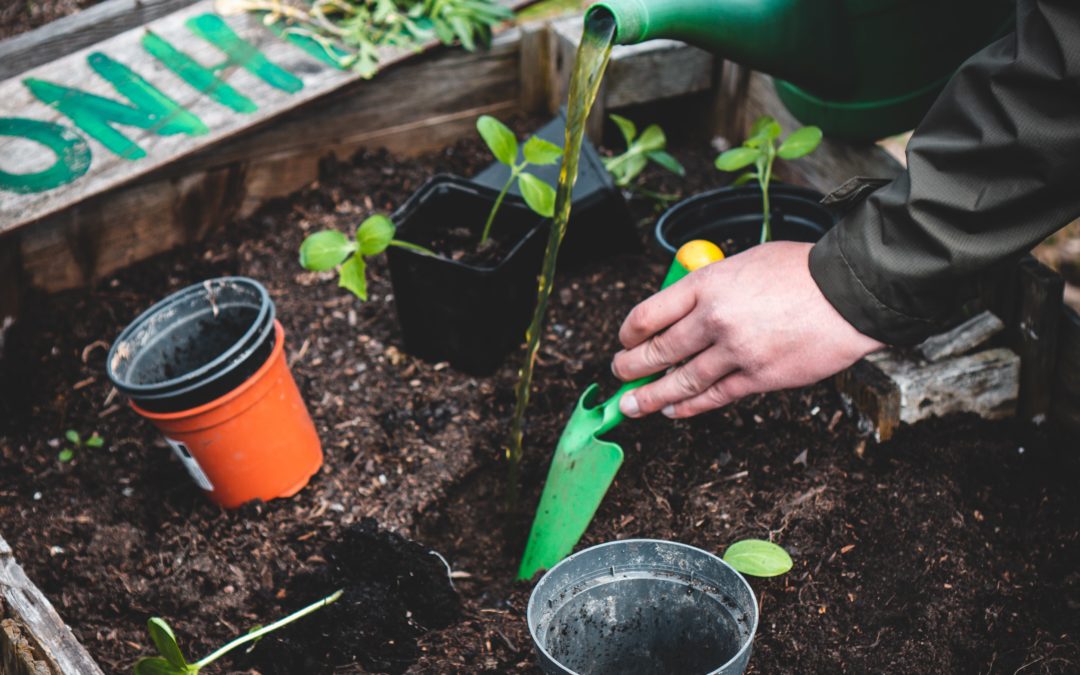Spring in northern Indiana can be warm and sunny one day and cold and rainy or even snow the next day. It’s a restless time for gardeners eager to get outside and dig in the soil and plant. Sowing seeds indoors in early spring will jump-start your garden and can be very rewarding for gardeners yearning to get their hands dirty. Here are some tips to get started:
What to start indoors?
Many vegetable plants do not tolerate the unpredictable temperatures of early spring or they have a slower root development. The vegetables below are best started indoors and planted outside after the danger of frost has passed, between April 22nd and April 28th in Michiana:
- Broccoli
- Brussels Sprouts
- Cabbage
- Cauliflower
- Celery
- Eggplant
- Peppers
- Tomatoes

How to plant seeds?
Choose a container that is at least two inches deep with adequate drainage. Compostable containers are a great option as they are inexpensive to buy and can be “planted” directly into the garden. If you are reusing non-compostable containers, always disinfect with soap and water prior to planting to eliminate any leftover pathogens or insects.
Plant seeds in a sterile potting mix and then top it with a layer of vermiculite or milled sphagnum moss in which the seeds are planted. After germination, the roots of seedlings move from this top area into the soil mix, which provides fertility.
How and when to sow the seeds?
The proper time for sowing seeds depends upon when plants may normally be moved outdoors. The periods range from 4 to 14 weeks, depending upon the speed with which seedlings grow. See the table below. Read the label on the seed packet for any planting instructions as well.
| Time to Seed Before Last Frost | Plant Types | Germination Time Days) | Growth Rate | Cold and Frost Tolerance After Hardening |
| 10 weeks | Broccoli | 6-10 | medium | good |
| 10 weeks | Cabbage | 6-10 | medium | good |
| 10 weeks | Cauliflower | 6-10 | medium | good |
| 10 weeks | Head Lettuce | 3-5 | medium | good |
| 7 weeks | Tomato | 6-10 | medium | none |
| 7 weeks | Eggplant | 7-14 | medium | none |
| 7 weeks | Pepper | 7-14 | medium | none |
| 4 weeks | Cucumber | 4-6 | fast | none |
| 4 weeks | Cantaloupe | 4-6 | fast | none |
| 4 weeks | Squash | 4-6 | fast | none |
| 4 weeks | Watermelon | 4-6 | fast | none |
Plant large-seeded vegetables such as cucumbers, watermelon, and cantaloupe directly into peat pots. Other seeds may also be handled this way to save transplanting. For small seeds, plant 2-3 seeds per pot and later thin to one plant. This saves later transplanting and means less root damage at planting time.
Cover the seeds with dry vermiculite or milled sphagnum moss. The depth of coverage depends upon the size of the seeds. Moisten the surface with a fine mist or place the container in a pan of warm water to absorb moisture from the base.
After watering, cover the container with plastic. Since they retain moisture, no additional watering should be necessary until after the seeds have germinated. Place seeds in a warm location for germination, but not in direct sunlight. Generally, a temperature range of 65-75 degrees.
Watch daily for germination, see the table above for average germination times. Move to bright light and remove the plastic as soon as germination is well underway.
How to care for plants after germination?
After seeds have germinated, they must be promptly given the best possible growing conditions to ensure stocky vigorous plants for outdoor planting.
Light. Seedlings must receive bright light promptly after germination. Place them in a bright south window if possible or under a fixture with two fluorescent lights.
Temperature. Most vegetables prefer night temperatures of 60-65 degrees. Day temperatures can run 10 degrees higher. If temperatures are warmer the result can be leggy plants.
Moisture and watering. Gently water plants with a mister to keep the soil moist.
How to move plants outdoors?
Plants that have been growing indoors cannot be planted abruptly into the garden without danger of injury. To prevent damage, about two weeks before planting, plants should be moved to cooler temperatures outdoors in a shady location. Gradually move the plants into the sunlight for short periods each day, increasing the time over the two-week period. Do not put tender seedlings outdoors on windy days or when temperatures are below 45 degrees.

How to transplant plants into the garden?
When plants have grown large enough to handle easily and hardening is complete, they may be planted into the garden. Planting on a cloudy day is best, if possible. Dig the hole about twice as large as the soil mass around the roots. Set the plants at about the same level they have been growing in pots. Place soil loosely around the roots and apply a 15-30-15 starter fertilizer, which is available at most garden or home improvement stores.
You can’t beat the satisfaction that comes with making the first sowings of the season. You know spring is almost here when the first shoots push through!
For more specific advice on gardening in Michiana, check the Purdue Extension site.
Have questions about home, auto, or umbrella coverage? Contact us today. We look forward to your call.
About the Authors

Connie Greenwood, Personal Insurance Advisor
Connie Greenwood has more than 35 years of experience as an Insurance Advisor. She enjoys helping her clients and prospects understand their insurance options, and crafting insurance solutions tailored to their unique needs. Connie finds great joy in being a trusted advisor for her clients. She loves helping protect their financial welfare against unforeseen accidents and circumstances and bringing them peace of mind.

Tim Pingel, Personal Insurance Advisor
Tim Pingel has over 20 years of experience as a personal insurance adviser. He provides individuals, couples, and families with home, auto, and umbrella insurance. His ultimate goal is to be his clients’ trusted adviser and expert, so they have the peace of mind and protection they deserve.

